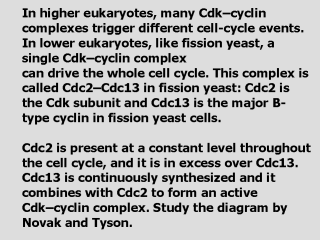 |
The Cdc2–Cdc13
complex formed is not necessarily active, because cells have at least three
different mechanisms to down-regulate its activity. 1/ Degradation of Cdc13
subunit, which is mediated by the APC (anaphase-promoting complex), which
requires Slp1 protein to recognize Cdc13. Degradation of Cdc13 is
primarily responsible for the Finish transition, 2/ Inhibitory
phosphorylation, which is mediated by Wee1 kinase, whose action is reversed
by Cdc25 activatory phosphatase. Inhibitory phosphorylation is used for the
regulation of the G2/M transition. 3/ Binding of an inhibitor (Rum1) to the
Cdc2–Cdc13 complex. Rum1 is continuously synthesized; when it becomes
phosphorylated, it is rapidly destroyed. The Rum1 Cdk-inhibitor stabilizes
the G1 state and is destroyed at the Start transition. G1 is also stabilized
by cyclin proteolysis, mediated by Ste9/APC (like Slp1, Ste9 is used by APC
to recognize Cdc13).
|
